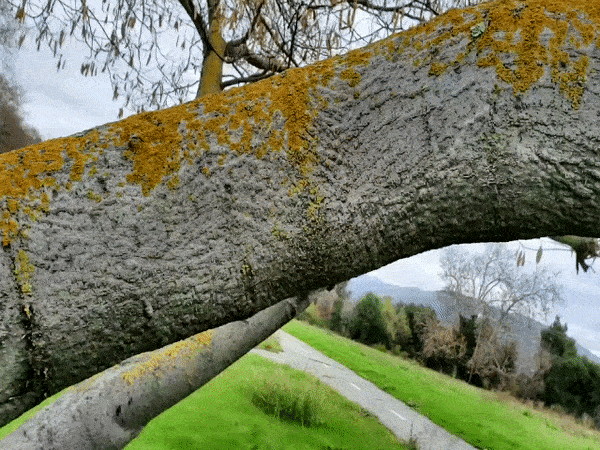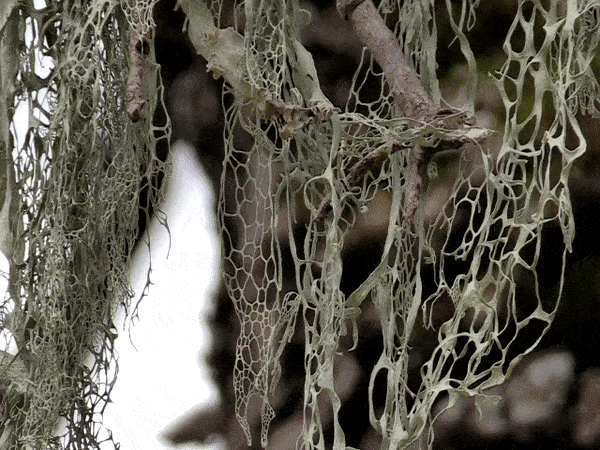Hello folks who wonder if the new American dream is about getting 500 likes on every instagram post and owning a personal refrigerator stocked with chilled beer when the global warming hits us,
Whether you "liche" it or not, lichens are one of those things that are gaining a lot of attention by naturalists everywhere in recent times.
What does that mean? That means more and more hikers are now at the risk of being exposed to butt cracks of passionate lichen lovers who are bent over on the side of the trails trying to get a closer look at the lichen.
Lichens are a fascinating group because they are comprised of more than one organism under the hood. You see, lichens are comprised of multiple fungi and algae or cyanobacteria that live in harmony and drape everything from our roofs, to tree barks, rocks and even statues.
Historically, researchers thought it was just one fungus and one alga sharing the apartment, but recent research has shown that there is more than one fungus in this relationship. When you have multiple organisms sharing the same roof, you need to lay some ground rules and decide who's going to do what. So in this case the Alga makes the food(photobiont) via photosynthesis and feeds the fungi, while the fungi provides shelter(mycobiont) and pays the rent.
The word "symbiosis" was first used in the botanical world to represent the union of these two unlike organisms working together inside a lichen structure. Everyone thought this relationship was what Disney movies promised us and the reason lichens live up to hundreds of years is because these roommates never fight with each other.
Since gauging the quality of air by observing how many people on the streets are wearing face masks won't work in today's environment(thank you Coronavirus!), we can use lichens to help us tell the same. Lichens can be grouped in Nitrogen sensitive, Nitrogen-Meh or Nitrogen-Bring it on camps. Using that information we can assess the levels of nitrogen dioxide in the air based on what kinds of lichens are growing in that area.
Stop for a while and think about the lichens you see in the nature preserves and now think of the lichens you see on the trees in your downtown area, chances are you won't see much overlap here. Anyways, one of the lichens that thrives in a nitrogen rich environment are the Xanthoria or the Sunburst lichens. But don't jump to conclusions just yet and start flipping every motorist passing by, since all it tells you that the substrate has high levels of nitrogen either in the air or that substrate is a porta potty used by local birds which is a rich source of nitrogen.
Below is a Xanthoria growing on a tree branch besides a busy street in San Jose.
The identification of lichens is not determined by simply noting the color. To be absolutely sure, one needs to note the substrate, look closely at the structure with a hand lens and finally to seal the deal, perform some chemical tests.
These chemical tests were designed back when bloodletting was performed by barbers and not the American Red Cross and haven't changed since the 1800s. There are 3 tests i.e. K test, C test and a P test. Combination of these tests are required in some cases as well.
Let's say you want to perform the K test, so you take a drop of the material listed as the ingredient in the K test and put it on the lichen and see if it reacts. If it reacts, that's a K+ else it is a K-. The logic behind this is that different lichens have different chemicals in them and those chemicals react differently to the chemicals in the spot test.
Below is one lichen reacting and changing color to one of the tests.
Finally, we all know or now know that Lace Lichen is the state lichen for California. Well how did they decide that Lace lichen was worthy of that title?
You see most of us, can't really tell one green lichen from another and do not have patience to bend over and look closely at the lichen. That is not the case with Lace Lichen which does not have any other lichen with close resemblance to its structure or form.
Below is the lace lichen up close hanging off a Coast Live Oak tree.
Whether you "liche" it or not, lichens are one of those things that are gaining a lot of attention by naturalists everywhere in recent times.
What does that mean? That means more and more hikers are now at the risk of being exposed to butt cracks of passionate lichen lovers who are bent over on the side of the trails trying to get a closer look at the lichen.
Lichens are a fascinating group because they are comprised of more than one organism under the hood. You see, lichens are comprised of multiple fungi and algae or cyanobacteria that live in harmony and drape everything from our roofs, to tree barks, rocks and even statues.
Historically, researchers thought it was just one fungus and one alga sharing the apartment, but recent research has shown that there is more than one fungus in this relationship. When you have multiple organisms sharing the same roof, you need to lay some ground rules and decide who's going to do what. So in this case the Alga makes the food(photobiont) via photosynthesis and feeds the fungi, while the fungi provides shelter(mycobiont) and pays the rent.
But, there are theories floating around that this relationship might not be truly symbiotic and Algae are getting the short end of the stick compared to the fungi who are just exploiting the poor algae looking for a place to crash in the age of increasing rents. This behavior is called "controlled parasitism".
Stop for a while and think about the lichens you see in the nature preserves and now think of the lichens you see on the trees in your downtown area, chances are you won't see much overlap here. Anyways, one of the lichens that thrives in a nitrogen rich environment are the Xanthoria or the Sunburst lichens. But don't jump to conclusions just yet and start flipping every motorist passing by, since all it tells you that the substrate has high levels of nitrogen either in the air or that substrate is a porta potty used by local birds which is a rich source of nitrogen.
Below is a Xanthoria growing on a tree branch besides a busy street in San Jose.
These chemical tests were designed back when bloodletting was performed by barbers and not the American Red Cross and haven't changed since the 1800s. There are 3 tests i.e. K test, C test and a P test. Combination of these tests are required in some cases as well.
Let's say you want to perform the K test, so you take a drop of the material listed as the ingredient in the K test and put it on the lichen and see if it reacts. If it reacts, that's a K+ else it is a K-. The logic behind this is that different lichens have different chemicals in them and those chemicals react differently to the chemicals in the spot test.
Below is one lichen reacting and changing color to one of the tests.
You see most of us, can't really tell one green lichen from another and do not have patience to bend over and look closely at the lichen. That is not the case with Lace Lichen which does not have any other lichen with close resemblance to its structure or form.
Below is the lace lichen up close hanging off a Coast Live Oak tree.






No comments:
Post a Comment
Did you learn something new in this post? Let us know in the comments below